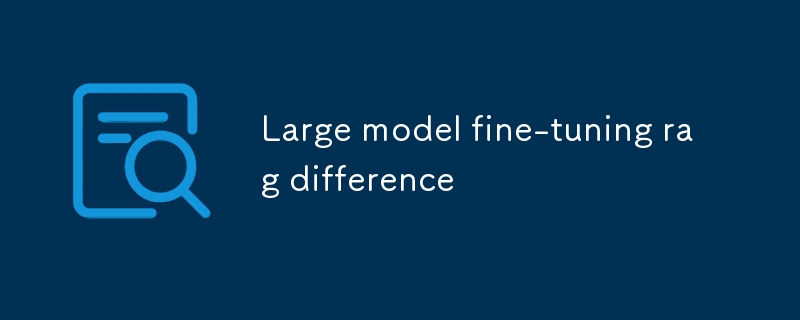Home >Technology peripherals >AI >Large model fine-tuning rag difference
Large model fine-tuning rag difference
- DDDOriginal
- 2024-08-13 16:24:18378browse
This article compares large language models (LLMs) and retrieval-augmented generation (RAG) models for text generation. LLMs excel in fluency and diversity but may lack relevance and coherence. RAG models prioritize relevance and comprehensiveness by

Large Language Models vs. Retrieval-Augmented Generation: What's the Difference?
Large language models (LLMs) are generative models trained on vast amounts of text data. Retrieval-augmented generation (RAG) models combine retrieval and generation techniques. In retrieval-augmented generation, an initial set of relevant documents is retrieved from a database, and then a language model is used to generate natural language text that is both relevant to the retrieved documents and coherent with the input prompt.
Key Advantages and Disadvantages of Each Approach
Large Language Models:
- Advantages: LLMs can generate text that is fluent, coherent, and diverse. They can also be used to generate text in a variety of styles and tones.
- Disadvantages: LLMs can generate text that is nonsensical or biased. They can also be expensive to train and require access to large training datasets.
Retrieval-Augmented Generation:
- Advantages: RAG models can generate text that is both relevant and comprehensive. They can also be used to generate text on topics for which there is a limited amount of training data.
- Disadvantages: RAG models can be more complex to train than LLMs. They can also be sensitive to the quality of the retrieved documents.
Impact on the Quality and Diversity of Generated Text
LLMs can generate text that is fluent and coherent, but it can be difficult to control the quality and diversity of the generated text. This is because LLMs are trained on very large datasets, and the quality of the generated text is often determined by the quality of the training data.
In contrast, RAG models can be used to generate text that is both relevant and comprehensive. This is because RAG models first retrieve a set of relevant documents, which helps to ensure that the generated text is relevant to the user's query. Additionally, RAG models can be used to generate text on topics for which there is a limited amount of training data.
Industry Applications
LLMs are well-suited for tasks such as generating marketing copy, writing scripts, and creating social media content. RAG models are well-suited for tasks such as generating news articles, legal documents, and customer service transcripts.
The above is the detailed content of Large model fine-tuning rag difference. For more information, please follow other related articles on the PHP Chinese website!
Related articles
See more- Technology trends to watch in 2023
- How Artificial Intelligence is Bringing New Everyday Work to Data Center Teams
- Can artificial intelligence or automation solve the problem of low energy efficiency in buildings?
- OpenAI co-founder interviewed by Huang Renxun: GPT-4's reasoning capabilities have not yet reached expectations
- Microsoft's Bing surpasses Google in search traffic thanks to OpenAI technology

